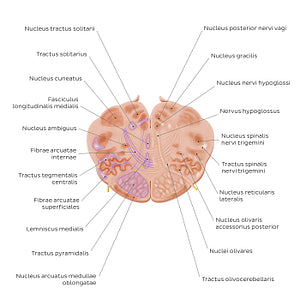Paul Kim
Medulla oblongata: Hypoglossal nerve level (Latin)
Medulla oblongata: Hypoglossal nerve level (Latin)
The various nuclei which make up the substantia grisea are mainly found within the dorsal part of the medulla oblongata, while the tracts, which form the white matter, pass mainly through the ventral part. At the level of the n. hypoglossus, the most prominent white matter landmarks are the pyramides medullares or tractus pyramidalis, the lemniscus medialis and fasciculus longitudinalis medialis. The decussatio lemniscorum medialium (decussatio sensoria) can also be identified at this level, in which axons from second order neurons emerge as fibrae arcuatae internae from the ncl. cuneatus et gracilis, and cross over the midline to form the lemniscus medialis of the contralateral side. Joining the fibrae arcuatae internae are the fibres from the tractus olivocerebellaris, which then travel in a posterosuperior direction to reach the pedunculus cerebellaris inferior. The most prominent gray matter structure on this level are the coiled nuclei olivares found dorsal and lateral to the pyramides medullares. Moving further dorsally we see the ncl. ambiguus, ncl. spinalis nervi trigemini, ncl. nervi hypoglossi and ncl. tractus solitarii. We can see how the n. hypoglossus extends from its nucleus and crosses the central portion of the medulla oblongata to exit at the tectum of the medulla. In the fissura mediana anterior, on the anteromedial surface of each pyramids is a small nucleus known as the ncl. arcuatus. It projects arcuatocerebellar fibers that form the striae medullares ventriculi quarti.
Normaler Preis
$7.56 USD
Normaler Preis
Verkaufspreis
$7.56 USD
Grundpreis
pro
Verfügbarkeit für Abholungen konnte nicht geladen werden


#CD6535
#A77562
#CD6535
#654536
#EBB690 und #CFAEAF

